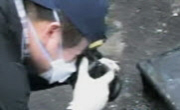As the population has continue to be concentrated with rising land prices and rapid development of vertical transportation technology, more and more buildings are skyscraping. Furthermore, the ultra high-rise buildings are expected to be built more in...
http://chineseinput.net/에서 pinyin(병음)방식으로 중국어를 변환할 수 있습니다.
변환된 중국어를 복사하여 사용하시면 됩니다.
- 中文 을 입력하시려면 zhongwen을 입력하시고 space를누르시면됩니다.
- 北京 을 입력하시려면 beijing을 입력하시고 space를 누르시면 됩니다.
초고층 건물의 화재발생시 연돌효과의 영향평가에 관한 연구 = (A) study on the stack effect in ultra high-rise buildings in case of a fire
한글로보기https://www.riss.kr/link?id=T11006618
- 저자
-
발행사항
서울 : 연세대학교 공학대학원, 2007
-
학위논문사항
학위논문(석사) -- 연세대학교 공학대학원 , 방재안전관리 전공 , 2007.8
-
발행연도
2007
-
작성언어
한국어
-
주제어
초고층 건물 ; 화재 ; 연돌효과 ; 제연댐퍼 ; 방화문 ; ultra high-rise building ; fire ; stack effect ; smoke control damper ; fire protection door
-
발행국(도시)
서울
-
형태사항
ix, 121 p. : 삽도(일부채색) ; 26 cm
-
일반주기명
지도교수: 김병선
- 소장기관
-
0
상세조회 -
0
다운로드
부가정보
다국어 초록 (Multilingual Abstract)
As the population has continue to be concentrated with rising land prices and rapid development of vertical transportation technology, more and more buildings are skyscraping. Furthermore, the ultra high-rise buildings are expected to be built more in order to activate the downtowns through efficient, economic and complex uses of the land as well as position them as city landmarks or symbols.However, ultra high-rise buildings are more vulnerable to disasters than ordinary buildings because they stand highest and widest. In particular a fire at the high altitude may result in a horrible disaster. The stack effect which was little recognized in the past when there were few ultra high-rise buildings is now being spotlighted as the most serious problem in the ultra high-rise buildings fire, since the smoke spread by the stack effect would be the primary source threatening the human life.Smoke control damper and fire protection door are important facilities designed to check and dilute the smoke spread by the stack effect in a skyscraper fire and thereby, help people escape from or fight fire smoothly. According to the result of a survey conducted by National Emergency Management Agency for operation of the smoke control facilities in 2006, about 33% of them were found in poor state. It was further confirmed that most of the fire protection doors leading to the escape stairway from fire were opened arbitrarily by residents, which means that the smoke control damper could not play their own roles. Such findings suggest that poor operation of the smoke control facilities would result in a terrible disaster in case a fire breaks out.The purpose of this study was to simulate the stack effect in a ultra high-rise building fire and thereby, analyze route, speed, pressure and concentration/distribution of the smoke spread by the stack effect and assess the influence of vestibule, smoke control damper and fire protection door over the smoke spread by the stack effect.For this purpose, the researcher reviewed relevant literature and mass media coverages, interviewed with relevant people, and thereupon, simulated a fire in an ultra high-rise building by using a CDF Interpretation program (STAR-CD). The scope of this study was set as follows;(1) Various theoretical aspects of the stack effects in a fire including its smoke-spreading effect(2) Problems of the ultra high-rise buildings in case of a fire(3) Smoke control facilities for ultra high-rise buildings(4) A fire simulation in consideration of the stack effectThe results of this study can be summarized as follows;As a result of simulating a fire in a skyscraper in consideration of the stack effects, it was found that the smoke generated from a fire in a lower part of the skyscraper would be induced by the stack effect into the elevator passage to be pushed up by buoyancy to infiltrate through the elevator door chasms into the smoke control areas (corridors). The results of assessing the influence of smoke damper in the vestibule of elevator and fire protection door over the smoke spread by the stack effect can be summed up as follows;(1) In case the smoke control damper does not work or its air supply volume is small or in case it works normally but the fire protection door is open, the smoke controlled areas would be filled with the smoke spread by the stack effect. After all, the smoke control damper would not play its own role of controlling and diluting the smoke for people''s smooth escape from fire or their effective fire fighting activities.(2) If the smoke control damper works normally with the fire protection door closed, the indoor air would be pressured by the air supply from the smoke control damper to be as high as 40~50Pa, and thus, the smoke spread by the stack effect would be controlled and diluted to help people escape from the fire or fight its smoothly. In such a case, the smoke control damper plays its original role of keeping the smoke off the smoke control areas on the same floor and additionally, plays the role of keeping the smoke spread by the stack effect from rising upwards.
국문 초록 (Abstract)
인구의 집중과 지가(地價)의 상승은 건축기술과 수직운송수단의 급격한 진보와 더불어 건물의 초고층화를 가속화시키고 있다. 아울러 토지이용의 효율성, 경제성 및 복합화를 통한 도심의 ...
인구의 집중과 지가(地價)의 상승은 건축기술과 수직운송수단의 급격한 진보와 더불어 건물의 초고층화를 가속화시키고 있다. 아울러 토지이용의 효율성, 경제성 및 복합화를 통한 도심의 활성화와 랜드마크(Landmark)로써 도시의 상징성 등의 이유로 초고층 건물의 건설은 더욱 활발해질 전망이다.그러나 초고층 건물은 고도의 무제한과 규모의 대형화란 태생적인 구조적 문제점으로 인해 일반 건물에 비해 재난에 많은 취약성을 노출하고 있으며 특히 높은 고도는 화재발생시 대형 재난의 원인이 될 수 있다. 이와 관련하여 초고층 건물에서 화재발생시 연돌효과로 인한 연기의 유입 및 확산은 생명을 위협하는 주요 요인으로 작용하기 때문에 과거 초고층 건물이 많지 않았던 시기에는 미처 인식하지 못했던 연돌효과(Stack Effect) 현상이 최근 초고층 건물의 높은 고도와 관련하여 화재발생시 큰 문제점으로 대두되고 있다.초고층 건물의 화재발생시 연돌효과로 인해 발생되는 연기의 억제와 희석을 통해 원활한 피난과 소화활동을 기대할 수 있는 중요한 방재시설로써 제연댐퍼와 방화문이 있다. 그런데 2006년 소방방재청에서 실시한 제연설비 운영실태 조사결과 약 33%가 불량인 것으로 나타났으며 이와 더불어 화재발생시 피난계단으로 이어지는 방화문의 대부분이 거주자의 편의에 따라 인위적으로 개방되어 관리됨으로써 화재발생시 제연댐퍼가 제 역할을 다하지 못할 것으로 확인되었으며 이러한 사실은 부실한 제연설비운영이 실제 화재발생시 대형 재난을 초래할 수 있다는 것을 의미한다.이에 본 연구의 목적은 초고층 건물의 연돌효과를 고려한 화재시뮬레이션을 통하여 초고층 건물의 화재발생시 연돌효과로 인해 유입되는 연기의 이동경로, 속도, 압력 및 농도의 크기와 분포를 분석하고 승강장 전실 제연댐퍼 및 방화문의 작용이 연돌효과로 인해 유입되는 연기에 미치는 영향을 평가하고자 함이며,본 연구에서 수행되는 방법은 문헌, 대중매체 및 관련 종사자와의 면담 등에 의한 조사·분석과 CFD해석 프로그램(STAR-CD)을 이용한 화재 시뮬레이션(Simulation)이며 연구의 범위는 아래와 같다.(1) 연돌효과의 이론적 접근을 통한 화재발생시 연돌효과의 역할(2) 초고층 건물의 화재발생시 문제점(3) 초고층 건물의 제연설비(4) 연돌효과를 고려한 화재 시뮬레이션본 연구의 결과는 다음과 같이 요약된다.(1) 제연댐퍼가 작동되지 않거나 급기량이 적은 경우 또는 제연댐퍼가 정상적으로 작동하나 방화문이 개방되어 있으면 제연구역은 연돌효과로 인해 유입되는 연기로 가득 차게 되어 결국에 제연댐퍼는 연기의 억제와 희석을 통해 원활한 피난과 소화활동을 유도하는 본연의 역할을 다하지 못하게 된다.(2) 제연댐퍼가 정상적으로 작동하고 방화문이 폐쇄되어 있으면 제연댐퍼의 급기로 인한 가압으로 제연구역내의 압력이 40~50Pa로 높아져 연돌효과로 인해 유입되는 연기를 억제하고 희석하는 역할을 함으로써 원활한 피난과 소화활동을 유도할 수 있게 된다. 이는 제연댐퍼가 해당층 실내에서 화재발생시 제연구역내로 연기의 유입을 억제하는 종래의 역할 외에, 저층부의 화재발생시 연돌효과에 의해 상층부로 유입되는 연기도 억제할 수 있다는 것을 의미한다.











